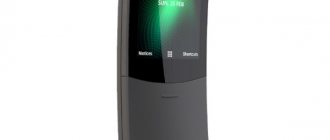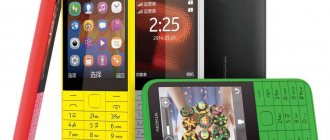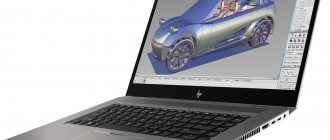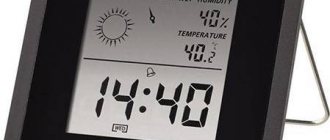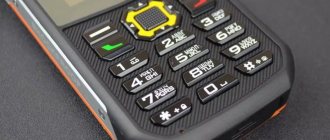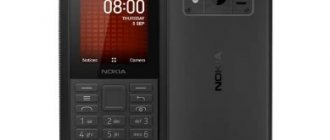I myself don’t like these new smartphones with widescreen displays. Firstly, as a rule, the keyboard often works crookedly when typing, since the sensor reacts purely to heat, and my fingers are thick like sausages and often I don’t get where I need to go. The problem is with the Android system, typing there is even more difficult, since the system for reading the signal from the display works crookedly in places.
Therefore, for 5 years in a row I have been buying myself pure push-button phones with WiFi, with a large screen and support for 3G, 4G Internet. In essence, these are all the same modern smartphones, only with a comfortable physical keyboard. And to be honest, I don’t like all these soulless glass displays on which you don’t even feel the keys being pressed.
I’ll say right away that all these push-button telephones are divided into two types according to the location of the keys:
- 12 buttons are standard, a classic that will never become outdated. They are more compact, but they take a little longer to type.
- QWERTY keys – everything here is like on a computer keyboard. Each key has its own separate letter or symbol. These phones are bulkier, but they are much more convenient to type on.
Nokia E52
A timeless classic. Battery capacity is 1500 mAh. Can work up to 40 hours while listening to music. There is an MP3 player. It was released in 2009 and is still running. There is a slot for a small microSD memory card. Supports Wi-Fi standards: 802.11b and 802.11g. The average cost is 5,700 rubles.
BlackBerry KEYONE
This model is more serious than the previous one, but it also costs more. Large screen with Android operating system. Screen resolution is 1620x1080 pixels. The 12 megapixel camera can shoot high-quality beautiful video in a resolution of 3840x2160. The powerful Snapdragon 625 processor prevents your phone from lag or lag.
It works very quickly, without interruption. Inside there is a lithium-ion battery with a capacity of 3505 mAh. Supports 5 GHz frequency over WiFi using the 802.11ac standard. This standard can transmit data at speeds of up to 1 Gbit per second. True, it is also expensive - 32,000 rubles.
Nokia 8110 4G – Wi-Fi router mode
This push-button phone with 4G Internet is aimed at the Russian market. The “8110” model has been popular since the release of the film “The Matrix”. From a visual point of view, the changes hardly affected it.
The device has a curved shape and has a slider lid, which can be pulled out to reveal the control buttons. The new Nokia is available in two colors: black and yellow (in working condition it looks like a banana).
As for the technical characteristics, the Nokia 8110 has a 2.45-inch display, a Snapdragon 205 processor, 512 MB of RAM and 4 GB of internal memory, which, unfortunately, cannot be expanded.
The KaiOS operating system supports popular instant messengers and applications, which include YouTube, Google Maps and others. You can insert two SIM cards into your phone at the same time. The 2 MP camera is suitable for taking simple pictures.
A battery with a capacity of 1500 mAh is enough for 5 – 7 days of use. Nokia 8110 with 4G and WiFi modem, if desired, connects to a computer.
True, there are questions about the assembly - some models are assembled with high quality, while in others the case “walks around”. Despite this, there are not many competitors among push-button phones with LTE now.
Pros:
- KaiOS with WiFi distribution - works as a modem;
- interesting form factor;
- clear speaker and microphone;
- without the Internet turned on it works for a week.
Minuses:
- build quality (loose cheap plastic);
- raw OS.
BlackBerry Curve 9360
A less powerful WiFi phone with built-in RAM of 512 MB. The built-in memory is of a similar size. Therefore, if you are thinking about taking this particular model, you should consider taking a MicroSD card in addition. The screen is small with a resolution of 640 by 480 pixels. But the main advantage is the comfortable keys. The developers made them convex and easy to press, so they can be used even blindly.
BlackBerry CLASSIC
The display is not that large, only 720 by 720. The size is quite compact, so it will be easy to carry in a bag or even a small pocket. Convenient buttons will make typing much faster.
It has a medium-power Qualcomm Snapdragon processor with a clock frequency of 1.5 GHz. But the built-in memory is pleasing - 16 GB out of the box. Plus you can connect another 64 GB from a memory card. By the way, you can easily make an access point out of it and distribute WiFi to other devices - be it a third-party phone, laptop, computer or even a TV.
How it looks and feels in the hands
When I saw the box with the smartphone, I was very surprised. The unusually small and slightly elongated device looked more like a control panel rather than a telephone.
This is what the trend towards larger screens in mobile gadgets has done to us. Although the dimensions of the Qin1S+ pushbutton are quite standard for its class.
Phone dimensions: 132x55x8.5 mm, and weight 95-97 g.
The appearance is a strict classic, the monoblock is made in black, gray, yellow and red colors are also available. The body is made of pleasant matte plastic, which, although it collects fingerprints, is not noticeable.
The screen is protected by Corning glass (the generation is not specified); there is even an oleophobic coating, which is rarely found in phones without a touch display.
The buttons are quite large, but because of this the phone does not look like a cheap “granny phone”. The design is similar to Nokia 230 and other phones from 5 years ago.
It’s unusual that there are no buttons or volume rockers on the ends. On the other hand, this way false positives are minimized, and you can change the volume in another way.
The device is pleasant to hold in your hands, but does not slip out and does not feel like a cheap Chinese dialer. The dimensions and thickness of the case are just right; you can talk by pressing the device to your ear with your shoulder.
If you are thinking about buying a case, it is better to order it along with your phone. For 100-150 rubles, the seller will add a high-quality silicone case to the kit; finding one after purchase will be problematic, and it will not always be possible to order it separately from the device.
The delivery set is spartan: a clip for removing the SIM card tray, a Type-C (yes, the device has a modern charging connector) and instructions in Chinese.
The charging block and headphones were not added. It is worth noting that the Qin 1S+ body does not have a 3.5 mm jack for connecting a headset. If necessary, you will have to look for a Type-C to 3.5 mm adapter, a headset with a modern connector, or use Bluetooth headphones. Not everyone will need this.
Other features worth noting are the lack of a camera in the device. Nobody expected a serious module in a push-button device; it’s good that the developers did not add a cheap 0.3 or 1.3 megapixel matrix.
BLACKBERRY KEY2
The latest system with fast performance Android 8.1 Oreo. Snapdragon 660 has 8 cores. The smartphone really works without any glitches, and programs open with lightning speed. RAM 6 GB - not all ordinary smartphones can boast of such a capacity, but here is a push-button phone. Supports Wi-Fi standards of both 2.4 GHz and 5 GHz. Rechargeable battery with a capacity of 3500 mAh. In general, I can easily actively use it for 2 days without charging. It’s true that the device is not cheap – 48,000 rubles.
They say there is Android here?
The device would not have aroused such interest in me if it were not a smartphone. Qin 1S+ runs the Mocor5 add-on based on Android 4.4 .
This means that most applications can be installed on it. There are no Google services here, as in the latest devices from Huawei, but installation of downloaded apk files is possible. They can be downloaded directly through the built-in browser, dumped onto a memory card or transferred over the network.
Fortunately, the smartphone has Wi-Fi and to manipulate data you do not need to use a computer or transfer it via Bluetooth (although this option is present).
In just a couple of minutes, on a well-known forum, I found a browser, messengers and a couple of banking clients already adapted to the screen size.
At first I didn’t quite understand how to work with programs without touch input, and later I found the Mouse Control item in the settings, which activates a convenient cursor.
This way you can use the joystick to access any menu item. Of course, no one will correspond every day or search for something on the Internet on such a device, but in rare cases you can make a call via Telegram or read mail.
If you have a computer and a suitable memory card, you can download Russified firmware. It took me no more than 20 minutes. Then I installed the Yalp Store application on my smartphone. With its help, if you have root rights, you can remove unnecessary standard and installed third-party programs.
But there is something to delete here. Half of the smartphone menu is occupied by Chinese assistants, instant messengers, services unsupported in our country, and other programs without localization.
You should fight not for space, which is already enough, but for cleanliness in the phone menu, which is half occupied by unnecessary rubbish. In addition, background processes are also removed along with programs, increasing the autonomy of the gadget.
Next, you will have to download a third-party QinPad keyboard to enter Russian characters for SMS or searching for contacts.
RUGGEAR RG310
For those who love to travel or often drop their phone. It is shockproof and has IP68 protection against water and small particles. Runs on Android 4.2. It has not an old, but a classic design. In some ways it even resembles a robot. Despite its tiny size, there is a 3600 mAh battery inside. Supports two SIM cards. The cost on the market of the CIS countries is up to 12,000 rubles.
No. 4 – ZTE F327
Price: 1,999 rubles
The compact ZTE F327 made of a plastic case allows the owner to work with two SIM cards at once, including on a 3G network. It also has a 2.4-inch screen with a resolution of 320x240 pixels. For show, there is a rear camera with a lens resolution of 0.1 MP and a slot for flash cards up to 64 GB. Battery capacity – 1000 mAh.
ZTE F327 is one of the cheapest 3G phones on the market, so its inclusion in our rating is not at all accidental. The mobile phone is assembled very high quality, so there are no questions about its reliability. The speaker volume is average, but you will probably hear a call from the next room. The menu is simple and intuitive, even an elderly person can understand it, plus the icons are large.
ZTE F327
SONIM XP6
Built-in RAM 1 GB. Supports Bluetooth and all modern mobile Internet standards. The processor is not the fastest at 1.2 GHz, but it doesn’t need more, since the OS is not demanding. What makes this baby stand out from everyone else is its very powerful 4800 mAh battery.
With constant and active use, you can use it for 40 hours, and during standby, up to 1000. The built-in memory is 8 GB - so you don’t have to buy a memory card. The camera is capable of shooting with a resolution of 2592x1944. Supports only Wi-Fi standards at 2.4 GHz. Water- and shock-resistant according to IP69 protection degree.
No. 5 – Philips Xenium E116
Price: 2,309 rubles
The first position from the end in our rating is represented by a completely ordinary push-button monoblock. The Philips Xenium E116 display has a diagonal of 2.4 inches and a resolution of 320x240 pixels. The phone has a 0.3 megapixel lens and 32 MB of internal memory. Battery capacity – 1600 mAh. The model supports work in 3G networks and with two SIM cards simultaneously.
The fact that a phone for 2 thousand rubles has 3G support makes you surprised at how quickly progress is moving in this market. This is certainly the main advantage of the model. In addition to this, I would also like to note the high-quality screen, the font on which is large, a loud speaker and a powerful battery that can provide the phone with excellent autonomy - in average use it is quite capable of lasting about 3-4 days without a power outlet.
Philips Xenium E116
BLACKBERRY PORSCHE
What pleased me first of all was the box. It is very high quality and beautiful. The processor has a frequency of 1.2 GHz and 768 MB of memory. Stylish design that goes well with a classic suit. Charging occurs via a special docking station, so you can simply place it on a special platform. At first I was confused by the 2,100 mAh battery, but in fact it works properly and does not drain quickly. Wi-Fi supports the 2.4 GHz standard – 802.11n.
The most useful and interesting features
The Chinese have added several interesting features to the device that make the device a real smartphone.
Qin 1S+ has LTE support and the ability to distribute mobile Internet via Wi-Fi. Unfortunately, the list of supported frequencies does not contain the “bands” of all domestic operators. Keep this in mind if you purchase a device to work with 4G.
Supported frequencies:
3G: UMTS 1900/2100/850/900 MHz 4G: TD-LTE band 1/2/3/5/8/38/40/41
There are no common frequencies band 7 and band 20.
Speed measurement on iPhone with LTE connection and modem mode on Qin 1S+
In modem mode, Qin 1S+ behaves well, the connection speed does not slow down. The device confidently holds 3-4 connected devices and can work in this mode for several hours.
The second interesting feature is the presence of an IR transmitter . The feature is quite common for Xiaomi smartphones.
So the phone can be used as a remote control for a TV, multimedia set-top box or air conditioner.
There is no need to train your smartphone, just find the model by manufacturer and go through the suggested settings.
As a result, we get a convenient IR remote control, access to which can be configured to one of the directions of the navigation joystick.
How to choose?
First of all, you need to decide on the type of keys. But I would still advise purchasing a device with a full keyboard. Firstly, printing on it is much more convenient and faster. Secondly, such phones have support for new versions of Android. That is, they are more powerful and faster.
But most importantly, such phones support all modern applications. A classic push-button phone often runs on Android Kit version 4 and lower. This OS does not support all programs from Google Play. On the other hand, the “classic”, with a smaller battery capacity, lasts longer and costs less.
Therefore, here you need to detach yourself from the needs of the buyer. If you don’t need all the bells and whistles of modern smartphones, then it’s better to take a classic, cheap model. If you need the power of a regular smartphone, but with buttons, then you’ll have to fork out more and take a closer look at the models.
The size of the screen is also of great importance, since if you constantly use a small device, your eyes begin to get tired. I won’t talk about the camera, since push-button smartphones with a good camera are very expensive and are often overpriced by 10–15 thousand. In this case, you should think about giving up buttons and buying the same iPhone from previous series. Its display response is better than Andryusha’s, but you probably already know about the camera.
Review of the Nokia 110 4G feature phone with support for VoLTE technology
The main feature of the Nokia 110 4G phone is its operation in 4G networks and support for VoLTE technology, that is, voice transmission over the LTE network, which at least potentially promises good quality voice communications.
Main characteristics of the phone
- Operating system Series 30+
- SoC Unisoc T107
- RAM 128 MB, ROM 48 MB
- Non-touch color display TN 1.8″, QQVGA 120×160 (3:4), protective mineral glass
- MicroSD support up to 32 GB
- Dual Nano-SIM support
- Network support: 2G (GSM): 850 / 900 / 1800 MHz
- 3G (UMTS/HSPA): 850 / 900 / 2100 MHz (bands 1, 5,

- 4G (LTE): 2100 / 1800 / 850 / 2600 / 900 / 800 MHz (bands 1, 3, 5, 7, 8, 20)
| Link to manufacturer's website | Nokia 110 4G |
| Retail offers | find out the price |
The phone and everything for it are packed in a small colorfully decorated box.
The package includes:
- Charger (110-240V, 50-60Hz at 5V, 550mA DC, 1m cable length)
- Battery
- Quick User Guide
- Warranty card (phone - 1 year, charger and battery - 6 months)
- Information sheet
The documentation is presented in Russian and Ukrainian.
Appearance
The phone body is made of black plastic.
On the box and on the website there are images of options with yellow and turquoise front panel and back cover.
The surfaces of the case are mostly matte, only the top and bottom ends are glossy.
There is a micro-relief on the back cover, which makes the phone less slippery and reduces the visibility of minor damage.
At the top end there is a 3.5 mm audio jack and a flashlight LED. On the bottom there is a Micro-USB connector. The microphone hole is on the front panel below the keyboard.
There are no side buttons.
There is a hole in the back cover for the camera. It is not equipped with a flash.
The tiny camera lens is covered with a circle of scratch-resistant mineral glass. Relative to the lid, the surface of this circle is slightly recessed.
The back cover is removed in the most common way - you need to pick it up from behind and pull the cutout in the corner with your index finger, resting your thumb in the center of the cover. By removing the cover, and then the battery, the user gains access to the card slots, that is, it is basically impossible to insert/remove/replace hot cards.
The SIM card slots are relatively convenient, as they are equipped with a movable folding latch.
The microSD card just needs to be slipped into the slot at the end of the niche.
The slot for the conversational loudspeaker, also known as the calling speaker, is located in the center horizontally above the screen.
The phone does not feel heavy for its size, it is held securely in the hand, and can be easily picked up from a table when it is lying face down, and even more so when it is facing up. There are no complaints about the width and length, since you don’t really need less, but the thickness could be reduced to at least 10 mm without any problems, and a thin phone bulges less in your pocket.
Buttons and their functions
Most buttons are formed by horizontal plates of relatively hard plastic that flex at the edges and in the center.
Two ridges in the center of the keyboard help you navigate the buttons by touch. The cursor buttons are formed by a slightly protruding square with rounded corners.
In the center of this square is a slightly recessed select button.
The fact that this button is recessed and framed by a square greatly reduces the likelihood of accidentally pressing it, which is important, since to unlock the phone you must first press this button. The travel of the buttons is small and not small, the pressing force is optimal - not tight, but there is no tendency to false presses, for example, when the phone is in the back pocket of jeans. The moment of operation is tactilely clearly felt, and a muffled click is heard. The square cursor button works well for pressing left-right and up-down. In general, all the buttons are easy to press even with the thumb of an average-sized hand. The surfaces of the buttons practically do not reflect, the symbols are quite contrasting, but the letters, of course, are small. In the dark, using the phone is made easier by a fairly bright and uniform backlight, which illuminates all the symbols on the buttons in white. The backlight turns on when you press any key.
Since for a push-button telephone it is of great importance which functions are called directly by pressing the buttons, we will consider them in more detail (within the framework of what was discovered experimentally).
| Button | Condition | Short press | Long press |
| Left | main screen | list of quick launch functions | No |
| Right | main screen | on cameras | No |
| Up | main screen | No | on off. flashlight |
| Down | main screen | contact list | No |
| Left | main screen | message editor | No |
| Right | main screen | calendar | No |
| Choice | main screen | list of applications/features | No |
| Answer | main screen | call log | No |
| Lights out | main screen | volume control, turn off, lock | switch off |
| 1 | main screen | dial number ('1') | voice mail |
| 2—9 | main screen | dial number ('2—9') | speed dial |
| 0 | main screen | dial number ('0') | launching an internet browser |
| * | main screen | dialing a number (brute force - '*' and '+') | dual SIM menu |
| # | main screen | dialing a number ('#') | overkill - sound off/vibration mode/sound on. |
| Choice | blocked | unlocking - subsequent pressing of the left button | No |
| 1 | text field | enumeration of signs and numbers 1 | entering the number 1 |
| 2—9 | text field | enumeration of letters of language 1 / numbers / letters of language 2 | entering numbers 2-9 |
| 0 | text field | iterate space/0/newline | input 0 |
| * | text field | character input list | No |
| # | text field | select input method - lowercase, uppercase, numbers, first capital | on off. predictive input |
| Right | text field | delete a character or exit if the field is empty | deleting all text |
| Left | cell phone conversation | menu - add call, call hold, recording on/off, microphone on/off, volume, contact list, call log, messages | No |
| Right | cell phone conversation | lights out | No |
| Up down | cell phone conversation | volume control | No |
| Choice | cell phone conversation | on off. speakerphone | No |
| Answer | cell phone conversation | call hold | No |
Note that the list of quick launch functions is editable; for example, you can add profiles there with settings for melodies, sounds and volume in order to quickly switch between them.
The functions of the buttons in the programs are more or less clear: the End button - cancel and exit directly to the main screen; right button goes back a level or deletes a character, left button — calls the context menu, enter — selects the current item or, for example, also calls the context menu, navigation joystick button — moves the input focus and/or cursor. Note that the lists in the menu are looped, which makes navigation easier.
Let's look at the lock function directly associated with the keyboard. To forcefully lock the keyboard, you need to press the end button from the main screen and then the left button under the screen. Unlock - enter and left button below the screen. It's difficult to accidentally unlock the keyboard. In the settings menu, you can set a timeout for user inactivity, after which the screen backlight first dims and then turns off (but it seems that this timeout cannot be changed). Separately, you can configure the automatic keyboard lock timeout.
Flashlight
The built-in flashlight is weak, but it’s enough to illuminate a keyhole and even steps in a dark flight of stairs. It's easier to turn the flashlight on and off from the unlocked home screen by holding the up button.
Sound
The quality of the loudspeaker during a normal conversation is good, the interlocutor can be heard clearly, and there is no interference caused by the phone itself. Its volume is sufficient to carry on a conversation in a not very noisy place. There are also no complaints about the microphone; the interlocutor hears you clearly, without interference. The quality of the speakerphone is much worse - the loudspeaker simply does not have enough volume, the sounds are distorted. The call volume will allow you not to miss a call even if the phone is in another room behind a closed door, but a lot, of course, depends on the melody itself. Note that the VoLTE function is disabled by default; it must be enabled in the settings menu or by typing a special command.
The vibration signal is weak for the user to feel it, the phone must be pressed tightly to the body, and even the phone lying on the table in vibration mode is difficult to hear.
The quality of the headphone output is average. The stereophonic effect is present, strong distortions and extraneous noise are not audible, the volume is sufficient, but there is no reserve for a noisy environment, there are also no low frequencies, the sound is a little harsh.
Power and communication with PC
Unfortunately, the connector for charging and communication with a PC is Micro-USB. The phone is fully charged with a current of about 0.5 A in a maximum of about 2 hours 40 minutes, while the CC phase takes a little more than 2 hours, after which the charging current gradually decreases. Consumption graph from the network when charging with a complete charger:
From a fully charged battery with very light use (almost in standby mode), the phone lasts about 4.5 days. Depending on the type of network, the manufacturer indicates standby time from 11 to 18 days, talk time from 6 to 16 hours, and gaming time 36 hours.
The BL-5C battery fits many other Nokia devices, which is, of course, good.
When connecting the phone to a PC via USB, the user is offered the choice of simply charging mode or also accessing the internal memory and microSD card. When you select the second mode, these two drives are seen on the PC as regular removable drives. This is very convenient in terms of ease of working with files on the phone. Note that if a card is inserted into the phone, then almost everything the phone writes to it, and only the voice recorder recordings by default end up in the phone’s built-in memory, but this can also be changed. Unfortunately, there is no USB modem mode, which reduces the benefit of 4G support.
Camera
The resolution of the pictures is only 240x320, the quality is terrible.
Day, street Room
You can take the risk of making a video, but it’s better not to look at the result.
Screen
The screen is one of the worst components of this phone. Not only is it small, only 1.8 inches diagonally (2.4″ looks much better, and 2.8″ is generally ideal for such body dimensions), but it is also very low resolution - 120x160 pixels. The situation is aggravated by the quality of rendering and translation of the interface, although this is not directly related to the screen. The fact is that only the English and some other versions of the interface have clear, pixel-by-pixel fonts. In the Russian version, the fonts are blurry and larger, plus translation features: very long inscriptions, often with errors. As a result, the ergonomics of the Russian version of the interface is very low; in some places it is simply impossible to understand what is written at all; if possible, it is better to switch to English localization.
For some reason, external protective glass is used, but it is at least mineral, so it does not scratch quickly. This glass also creates an air gap between itself and the LCD matrix itself. This gap reduces the anti-glare properties of the screen, which, coupled with the not very high brightness, makes it difficult to use the phone outdoors on a sunny day. Although it cannot be said that in the sun the screen is completely unreadable - it is enough to set the brightness to maximum and rotate the screen so that something dark is reflected in it, then everything is more or less visible. Maximum brightness reaches 380 cd/m². The minimum brightness value is 30 cd/m². In complete darkness, the brightness can be reduced to a comfortable value. Brightness is adjusted using PWM at 642 Hz. The flicker is not visible to the eye, but still the frequency is not very high, therefore, in the test for the stroboscopic effect, the presence of modulation is revealed. Graphs of brightness (vertical axis) versus time (horizontal axis) for different brightness settings:
The TN matrix used in the screen causes the following unpleasant properties: even with a slight upward deviation from the perpendicular to the screen, dark shades are inverted; with a downward deviation, light shades are inverted, but at least to a lesser extent. Also, with the smallest deviation up or down, the black field is very brightened. The picture remains more or less stable only when deviating left and right, but still, due to the greatly changing picture, even with small movements of the phone it is unpleasant to look at the screen.
Narrow color gamut:
The spectrum shows a large blue peak and strong cross-mixing of components:
The color temperature on the white and gray fields is not very high, about 9000 K, and the deviation from the blackbody spectrum (ΔE) is about 1 unit, that is, at least the color balance is not the most disgusting.
Software
Before moving on to a brief description of the applications built into the phone, let’s look at some of the functions (not all, but those that interested us) available in the settings menu. There is a blacklist for calls and receiving messages. For the main screen, you can select one of the preset backgrounds or a custom image. You can choose what to display on the main screen below the top line with icons, for example, you can hide the status bar for the second SIM card when it is not present, or display the timer countdown when it is running. You can select text for menus, etc. larger, although in the small text version little will fit on the screen. For the application menu, you can choose to display small icons in three columns and three rows or one large icon on the screen.
There is a function to create a backup copy of contacts and messages on a memory card or in the phone memory and restore from it.
Call log - lists of missed, dialed, received and rejected calls. You can delete everything and see the time of the last, received, dialed and all calls in total.
Please note that 5 minutes after a missed call, the phone will remind you of this once with a short signal.
Contacts - a list of all contacts and contacts on SIM1/2 and by groups - Family, Friends, Work and Odnoklassniki. You can search everywhere by number or name. You can set an icon on a contact (almost useless, since it appears tiny when calling), a name (30 characters if in Latin, and only 15 if in Cyrillic), two numbers - mobile and home, and you can also assign the contact to one of four groups.
It supports importing and exporting contacts using VCF files (the name is taken from the FN field, while the Russian text must be in UTF-8, the number is entered in both fields for mobile and home) and copying selected contacts from SIM to the phone memory and vice versa. You can store 2000 contacts in the phone's memory.
Gallery —view raster images. Minimum functions. The picture can be enlarged by shifting the area displayed on the screen. The image can be set as the home page background or contact icon. You can run a slideshow with transition effects.
It is noteworthy that you can display the image on the entire screen without any extraneous icons and 1:1 pixel by pixel.
Internet - launching the Opera Mini Internet browser, which on such a screen in modern realities is completely useless.
Message —working with SMS messages. It’s relatively convenient to work with a list of messages, but the editor is primitive: text insertion is not supported, only numbers from the contact list. There is no switching of the input language - when you press the button, the characters of the first language are first sorted, then a number is entered, then the characters of the second language are sorted. It's so inconvenient, but it happens in all text fields. It is possible to create mailing lists.
Camera - launches the camera, there are no settings, you can switch to video recording mode and back to photography.
Snake is the only game that can be played for free without restrictions.
FM radio - does not require headphones to operate, but with them there may be less interference, and can also work in the background. The reception quality, if in a more or less open area, with headphones and not in stereo mode, is good. In other cases - bad.
Music is a very simple audio player, it can work in the background, and plays at least MP3 and WAV.
Video is a very limited video player. At a minimum, it can reproduce what the phone itself recorded.
The signal is an alarm clock. You can set three events, the sound can be selected from two presets or from a file, and it can also be recorded from a microphone. You can postpone it for 5 minutes.
English with Oxford , Arrow Master , Racing attack and a few more games in the Other games - games with free trial attempts, to continue you need to pay via SMS, and even Tetris is paid!
File list - file browser. Supports basic file operations, a very useful program.
And in the Advanced :
Read —reads out text in a menu, a dialed number, an incoming call (reads a number or name from the address book), or a message displayed on the screen. You can choose what exactly to read, you can also adjust the volume, choose a higher or lower voice and the reading speed. Sometimes this feature can be useful.
World time - view the time in several cities to choose from.
Timer - countdown time with discrete settings of one minute.
Conversion of units - conversion from one unit to another (weight and length, well, there are very few options).
Calculator - addition, subtraction, multiplication and division.
Calendar - calendar plus event schedule.
A flashlight is an alternative way to turn it on/off.
Voice recorder - you can choose from three recording formats - AMR, MP3 or WAV.
STK - SIM card menu.
conclusions
It's hard to come up with a rationale for why someone would want to buy this particular phone. Unless you really, really need a push-button device that supports 4G and VoLTE. Among the good things, it is worth noting a comfortable keyboard and a locking system without a tendency to accidental removal, a removable battery of a common format, two SIM cards (which is no longer surprising), the ability to export and import contacts, convenient quick access to a number of functions and partially customizable quick access menus and the appearance of the main screen, the presence of a flashlight, as well as the function of speaking texts. I didn’t like it: a tiny screen of very low resolution, no camera at all without a flash, small letters on the buttons and only one completely free game.
